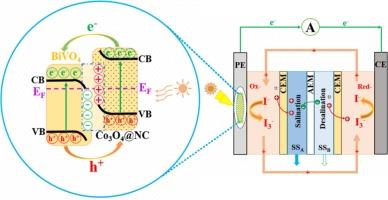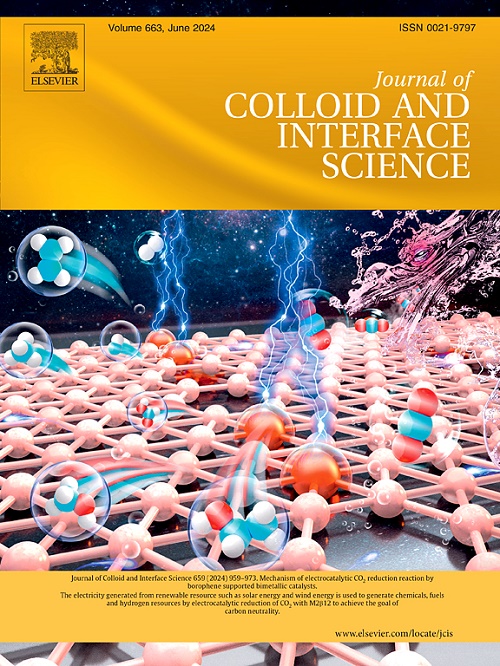Enhanced photoelectric desalination of Co3O4@NC/BiVO4 photoanode via in-situ construction of hole transport layer
IF 9.4
1区 化学
Q1 CHEMISTRY, PHYSICAL
引用次数: 0
Abstract
The solar-driven photoelectrochemical desalination (SD-PED) technology, as a new emerging desalination technique, has been developed and attracted the increasing attention. However, practical application remains hampered by several constraints, including the rapid deterioration of photocurrent, and the long-term stability of system. In this research, MOF-derived nitrogen-doped carbon@Co3O4/BVO (Co3O4@NC/BVO) heterostructured photoanode was design for efficient and durable solar driven redox desalination. It exhibits an initial photocurrent of 2.40 mA/cm2 and a desalination rate of 69.01 μg/(cm2·min) in the zero-bias state using the light as the driving force, without consuming electrical energy. Furthermore, the solar energy consumption of the photoanode is 0.187 μmol/J. The salt removal rate fluctuates within 1.36 μg/(cm2·min) throughout five cycles without any substantial decrease. Photo-luminescence, EIS and Mott-Schottky analysis are also performed to investigate interface reaction, charge separation and transfer mechanism between photoanode and electrolyte. The analysis of the charge-transfer paths on the heterojunction interface is conducted through in situ irradiation XPS. Further analysis of the generation and separation of •OH and h+ in the Co3O4@NC/BVO photoanode using electron paramagnetic resonance (EPR) showed that Co3O4@NC as an efficient hole transfer layer can effectively promote the separation and transfer of photo-generated electrons and holes. The excellent desalination performance is attributed to the synergistic effect of electron transfer in the Co3O4@NC/BVO heterojunction and hole transport in the Co3O4@NC efficient hole transport layer. This work is significant for the development of solar redox flow desalination.

通过原位构建空穴传输层增强 Co3O4@NC/BiVO4 光阳极的光电脱盐能力。
太阳能驱动的光电化学海水淡化(SD-PED)技术作为一种新兴的海水淡化技术,已经得到开发并引起越来越多的关注。然而,光电流的快速衰减和系统的长期稳定性等制约因素仍然阻碍着该技术的实际应用。本研究设计了氮掺杂 MOF 衍生碳@Co3O4/BVO(Co3O4@NC/BVO)异质结构光阳极,用于高效、持久的太阳能驱动氧化还原海水淡化。它的初始光电流为 2.40 mA/cm2,在以光为驱动力的零偏压状态下,脱盐率为 69.01 μg/(cm2-min),且不消耗电能。此外,光阳极的太阳能消耗量为 0.187 μmol/J。在五个周期内,盐分去除率在 1.36 μg/(cm2-min)的范围内波动,没有大幅下降。此外,还进行了光致发光、EIS 和 Mott-Schottky 分析,以研究光阳极与电解质之间的界面反应、电荷分离和转移机制。通过原位照射 XPS 分析了异质结界面上的电荷转移路径。利用电子顺磁共振(EPR)进一步分析了 Co3O4@NC/BVO 光阳极中 -OH 和 h+ 的产生和分离,结果表明 Co3O4@NC 作为高效的空穴传输层能有效促进光生电子和空穴的分离和传输。优异的海水淡化性能归功于 Co3O4@NC/BVO 异质结中电子转移和 Co3O4@NC 高效空穴传输层中空穴传输的协同效应。这项工作对太阳能氧化还原流海水淡化的发展具有重要意义。
本文章由计算机程序翻译,如有差异,请以英文原文为准。
求助全文
约1分钟内获得全文
求助全文
来源期刊
CiteScore
16.10
自引率
7.10%
发文量
2568
审稿时长
2 months
期刊介绍:
The Journal of Colloid and Interface Science publishes original research findings on the fundamental principles of colloid and interface science, as well as innovative applications in various fields. The criteria for publication include impact, quality, novelty, and originality.
Emphasis:
The journal emphasizes fundamental scientific innovation within the following categories:
A.Colloidal Materials and Nanomaterials
B.Soft Colloidal and Self-Assembly Systems
C.Adsorption, Catalysis, and Electrochemistry
D.Interfacial Processes, Capillarity, and Wetting
E.Biomaterials and Nanomedicine
F.Energy Conversion and Storage, and Environmental Technologies

 求助内容:
求助内容: 应助结果提醒方式:
应助结果提醒方式:


